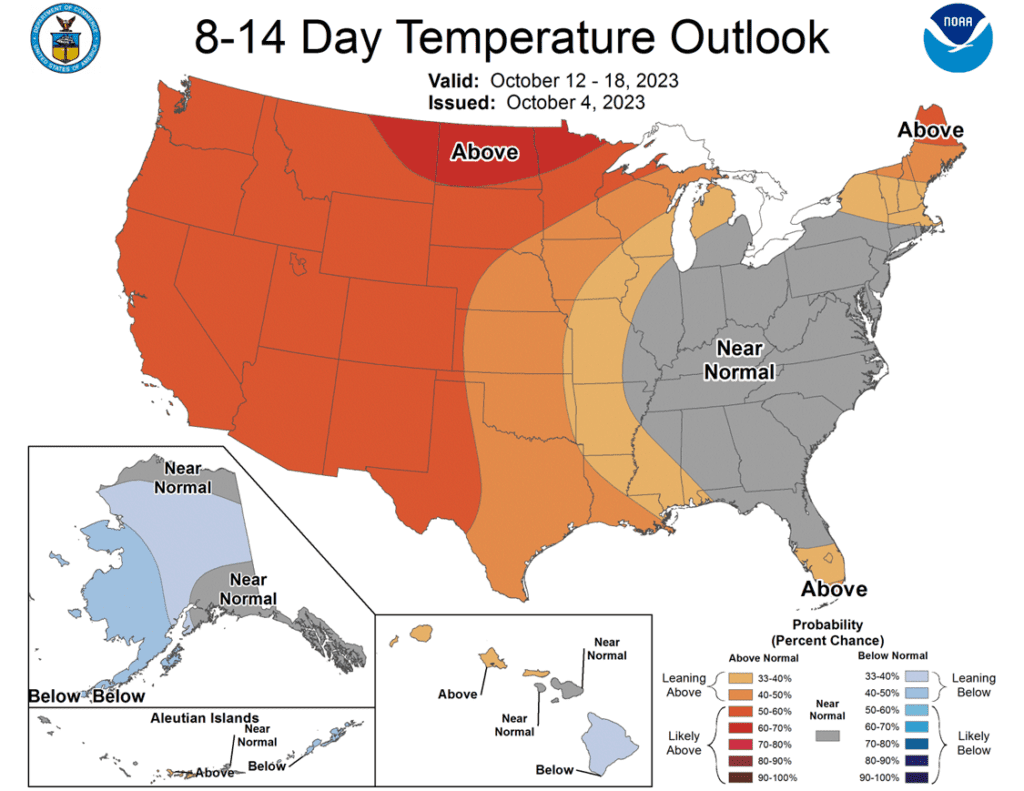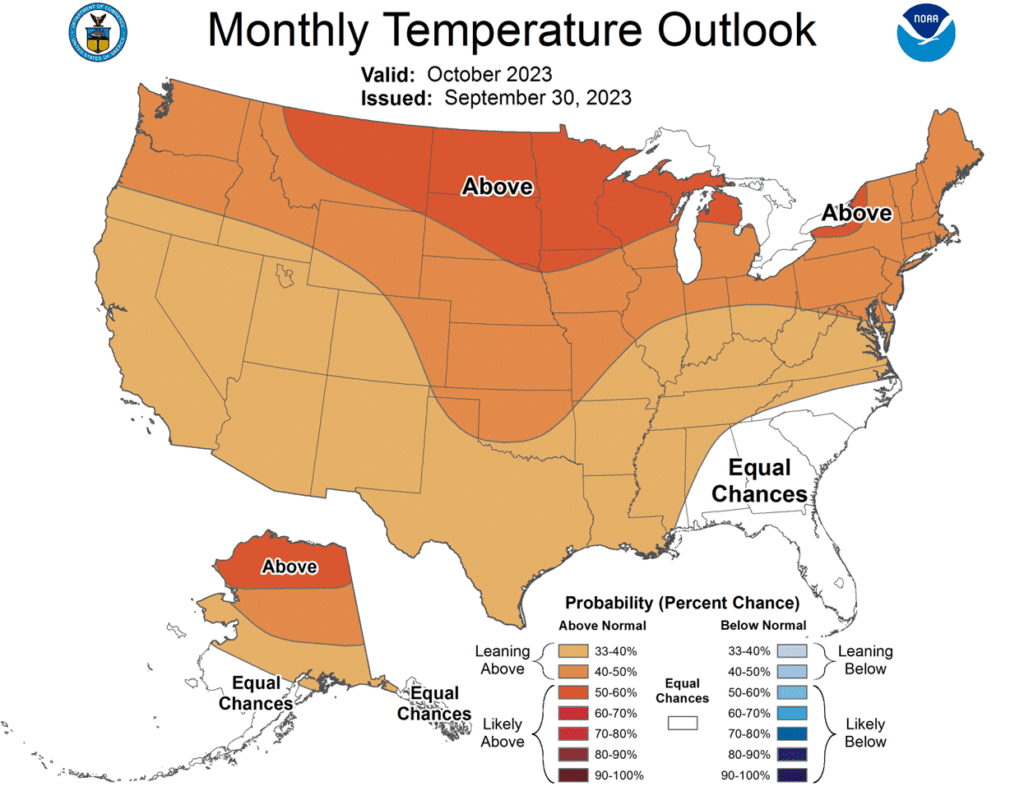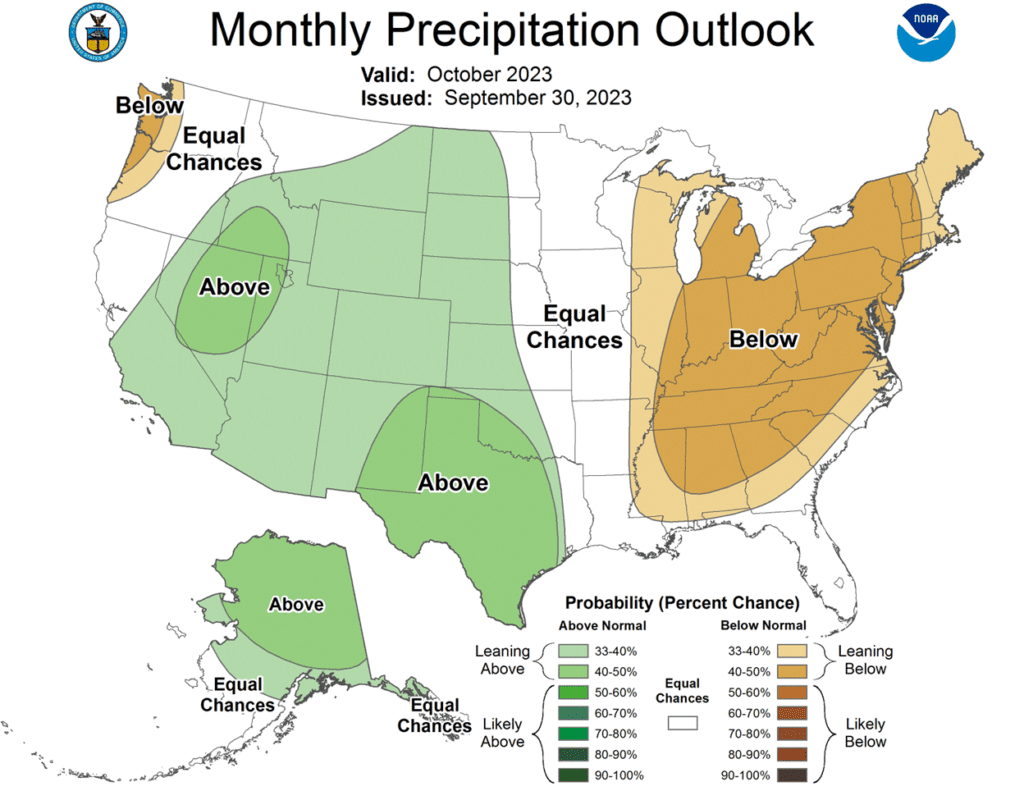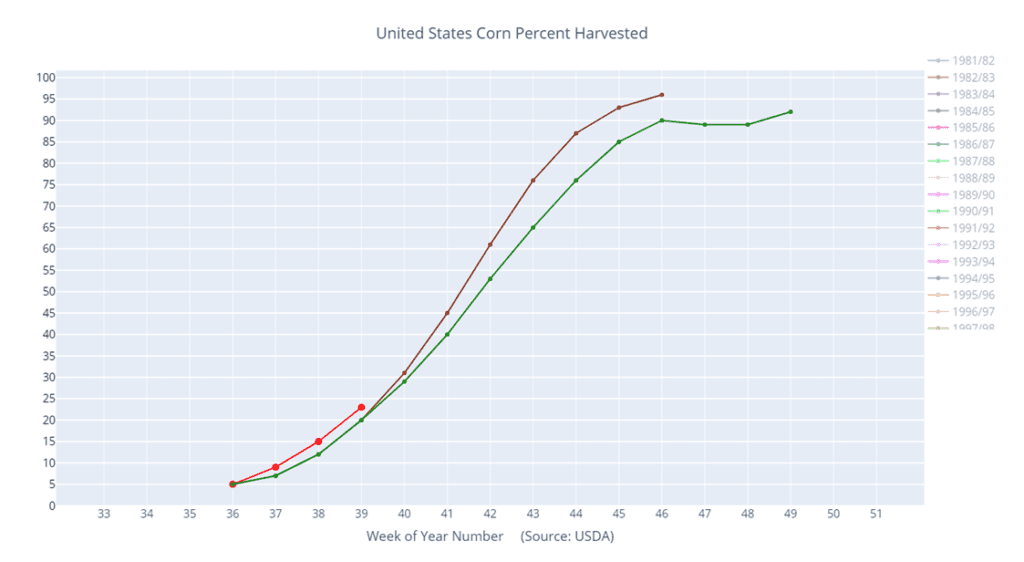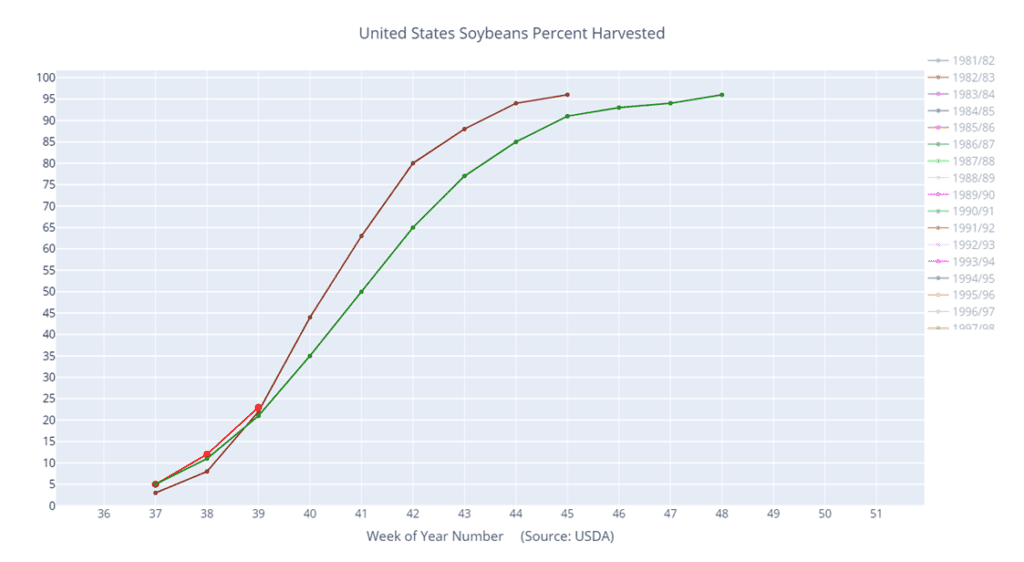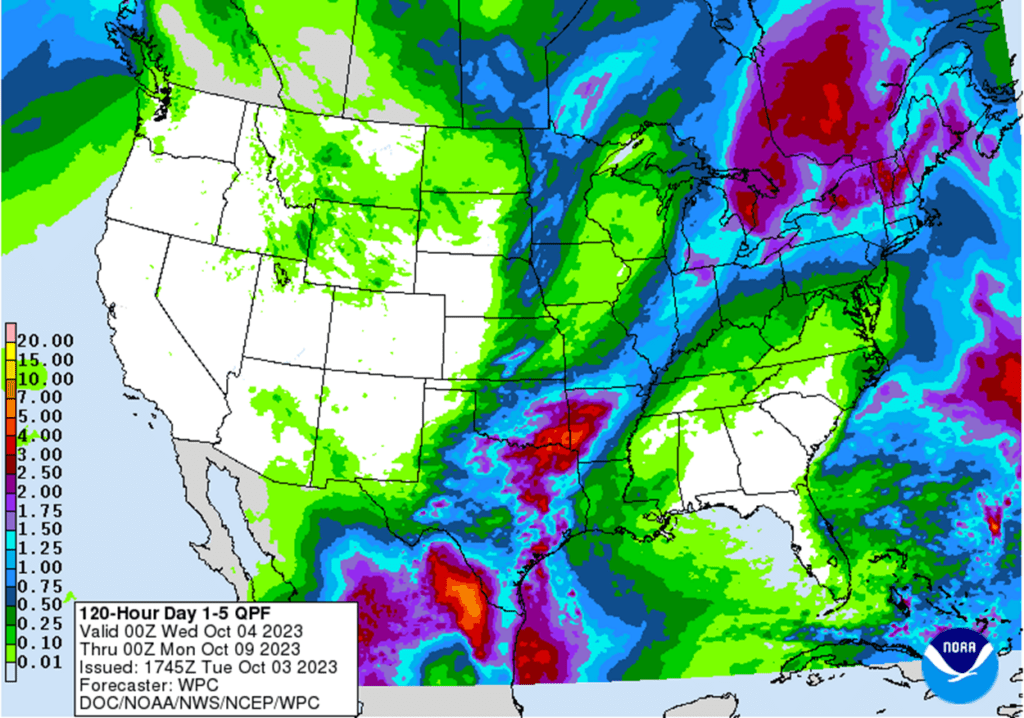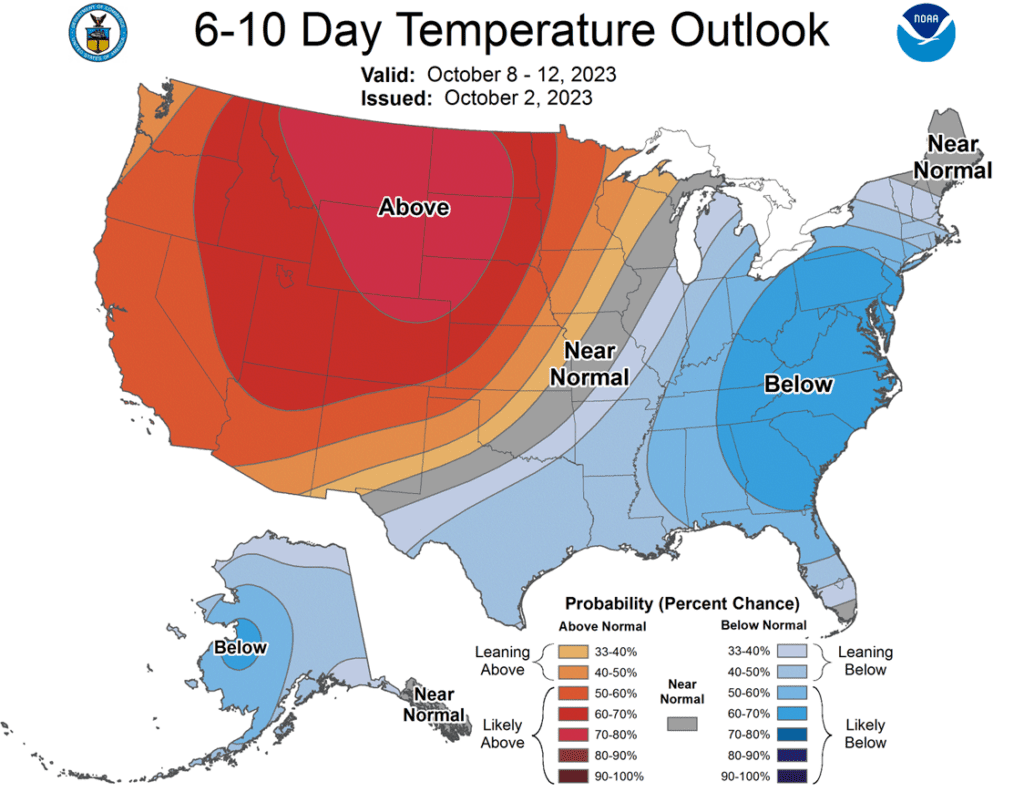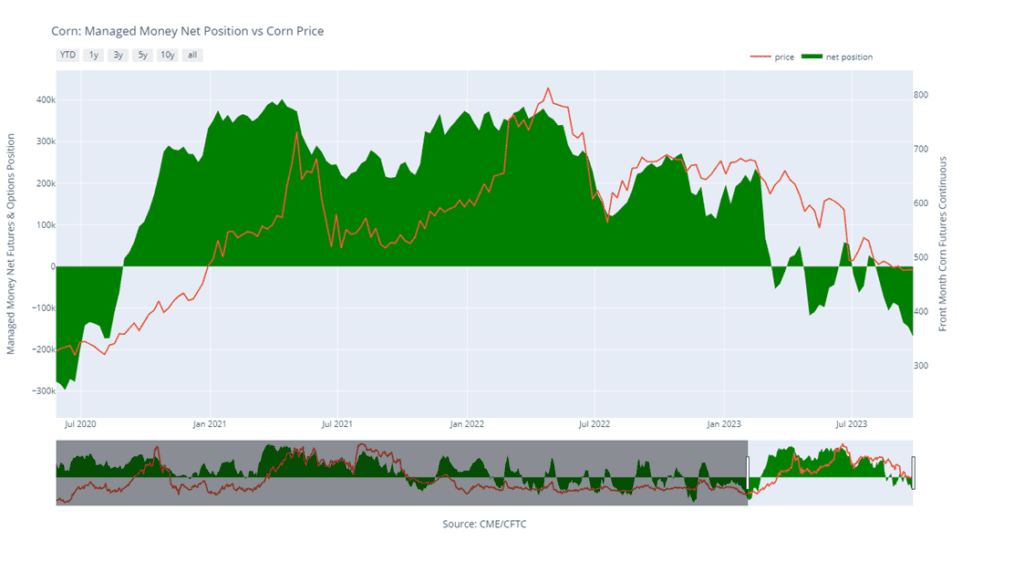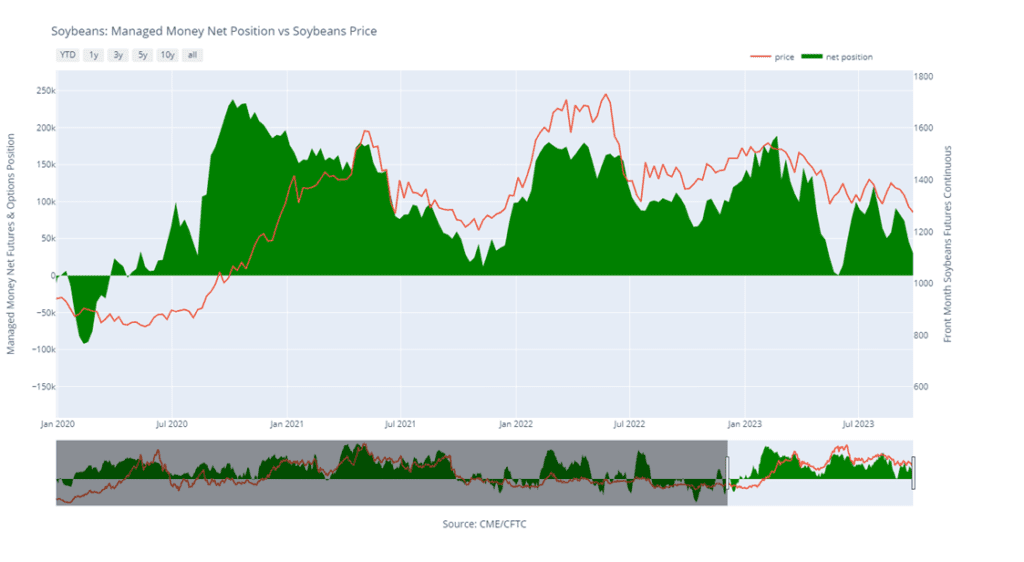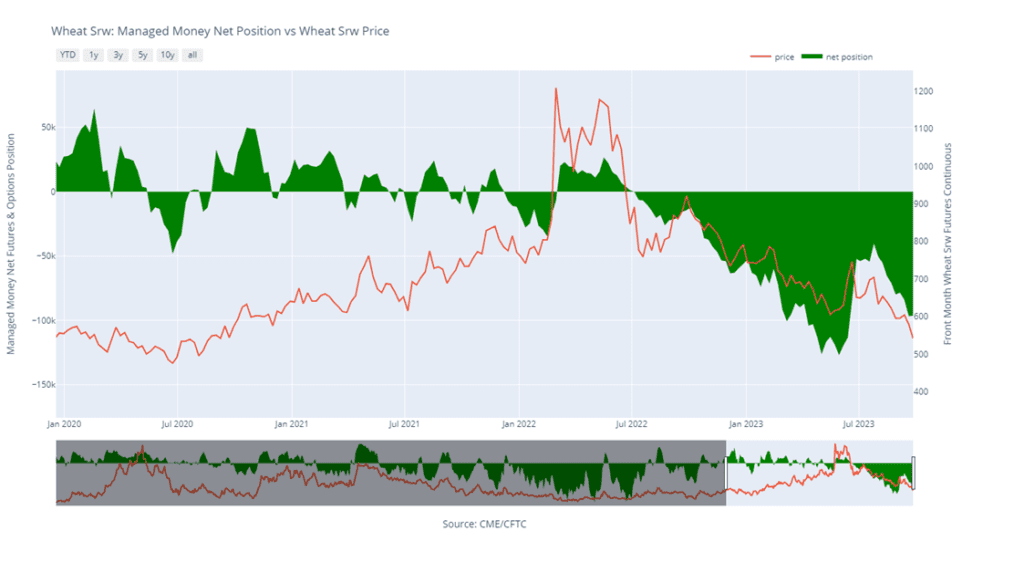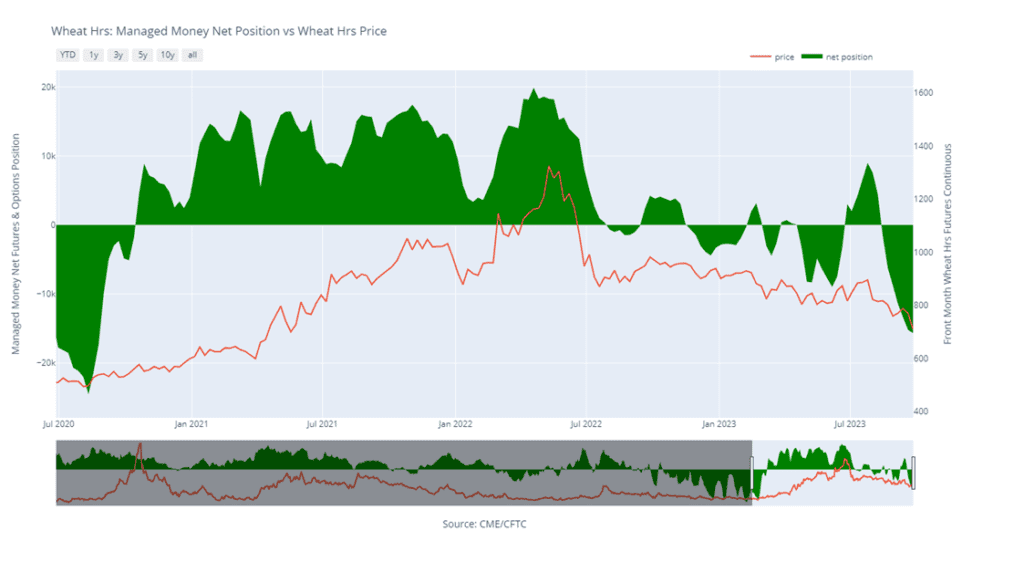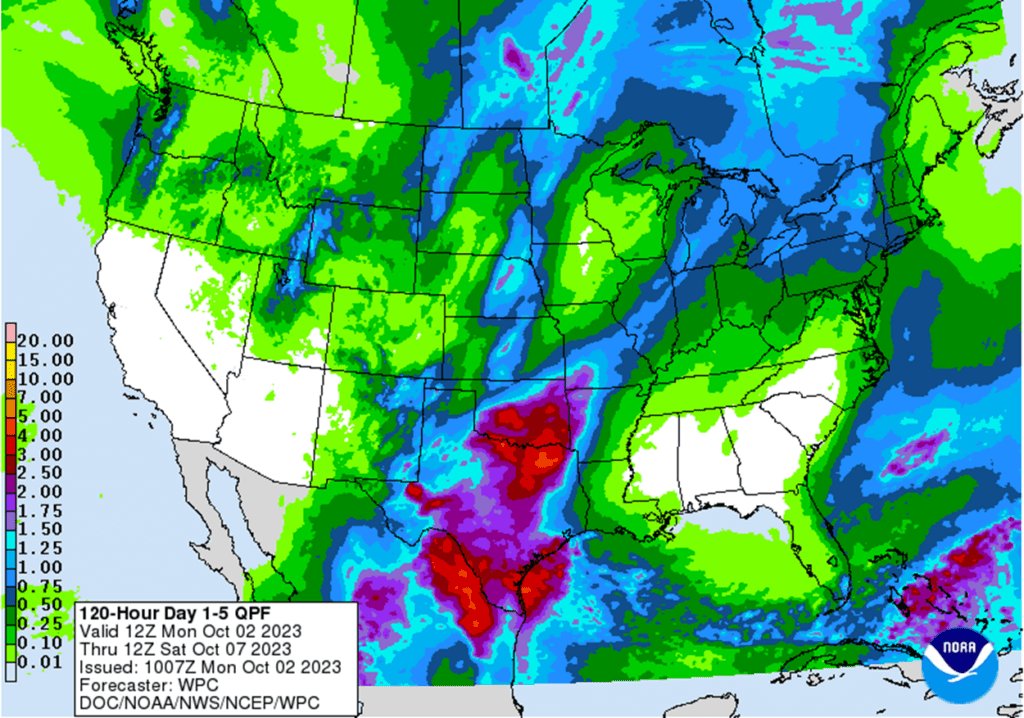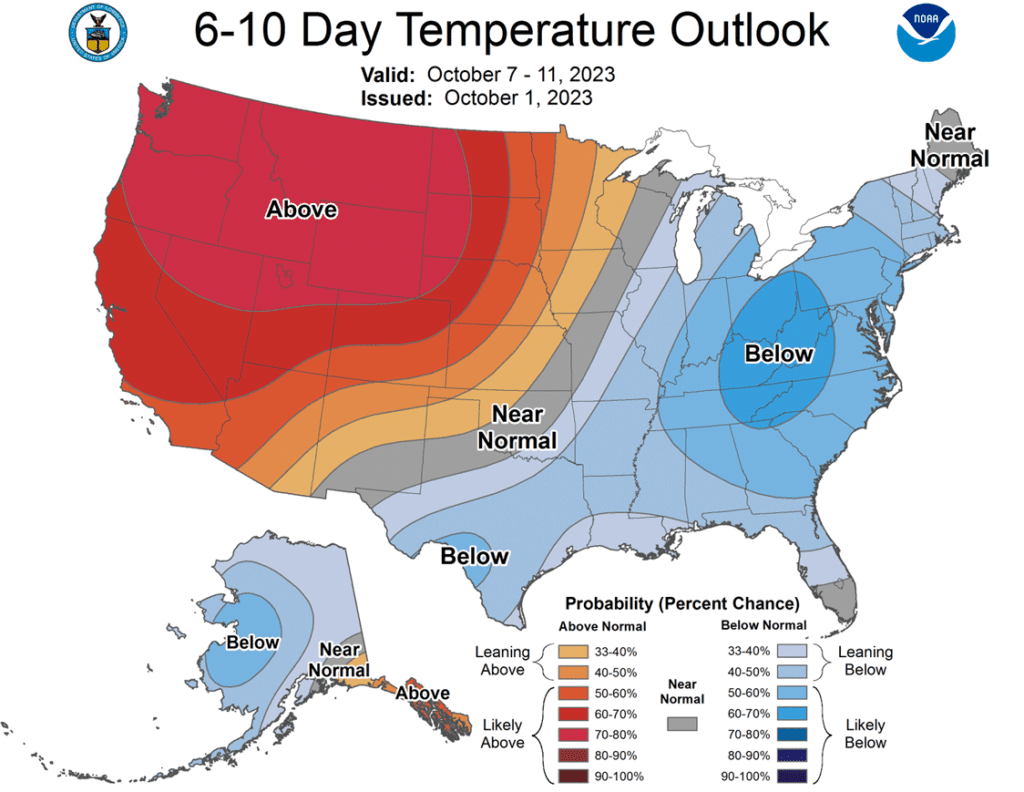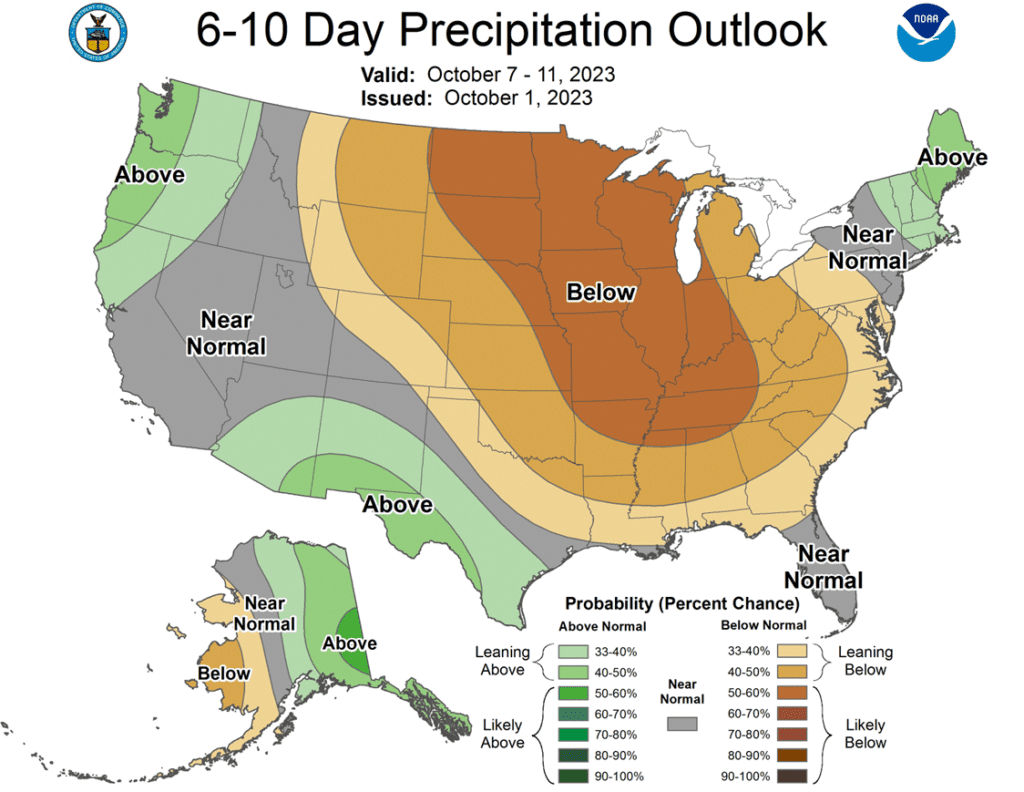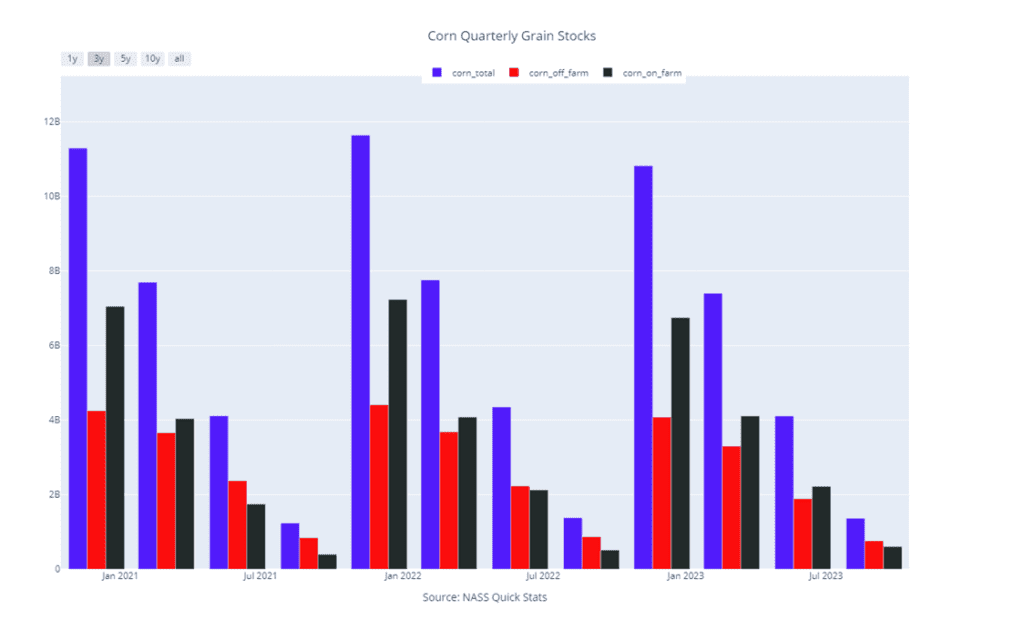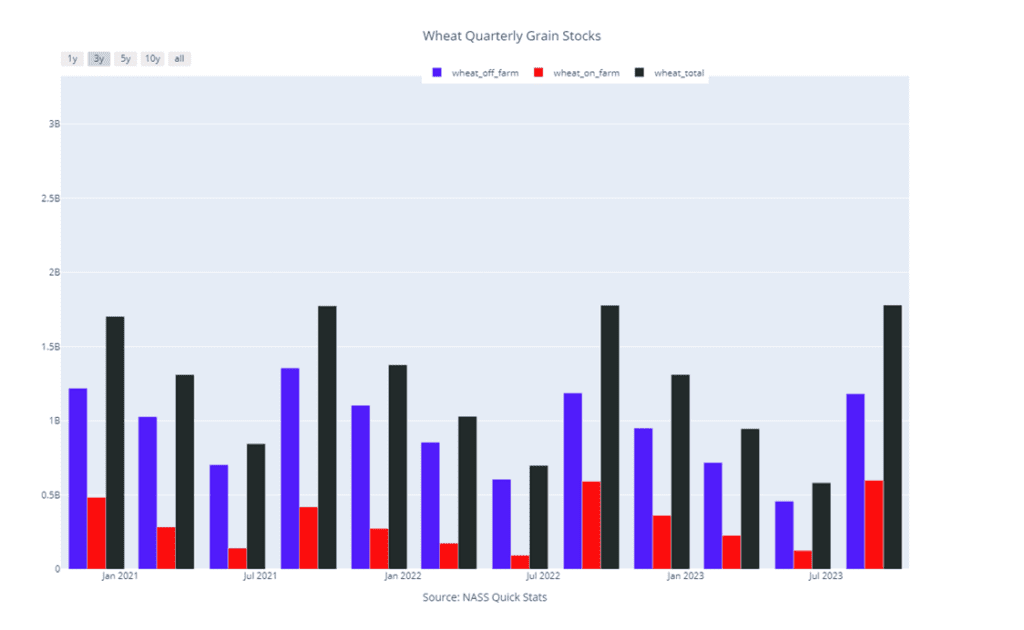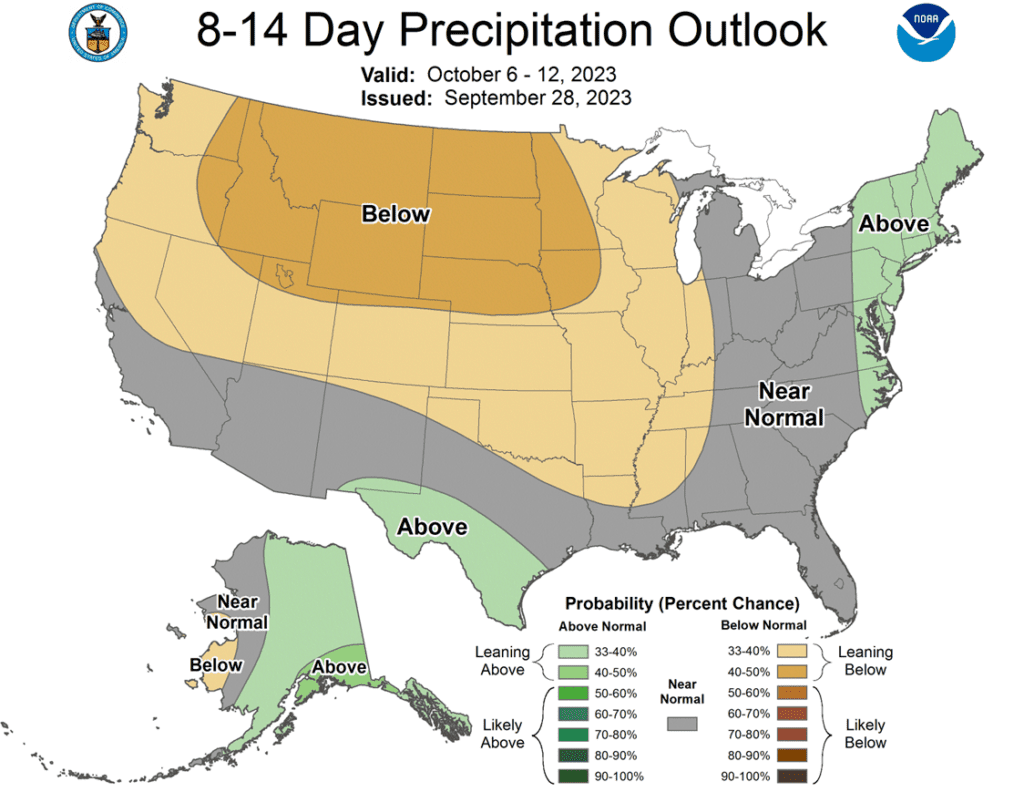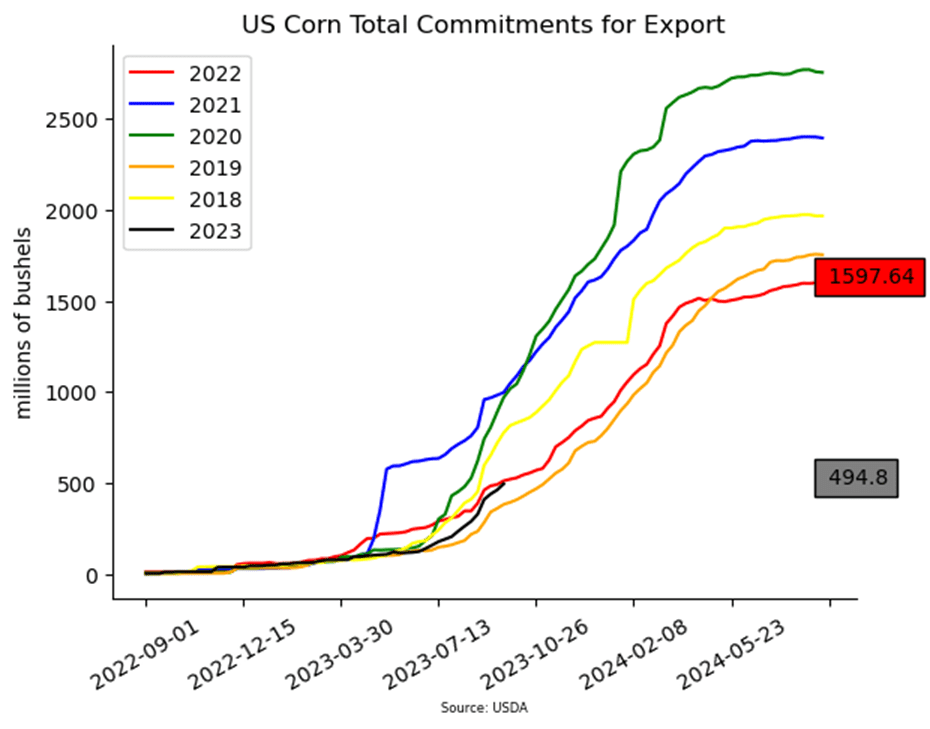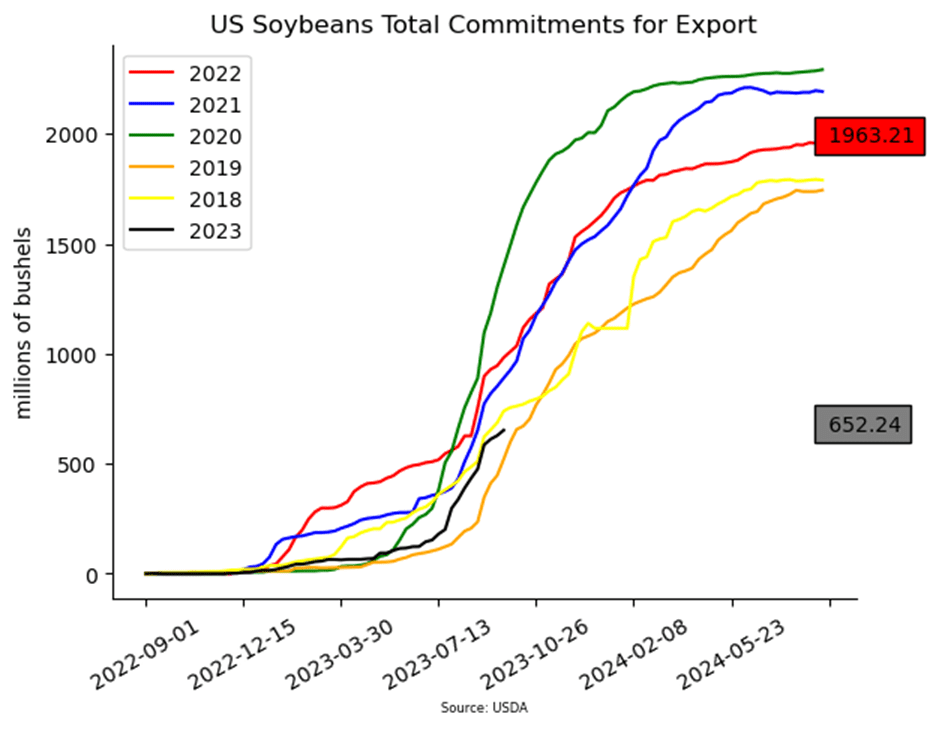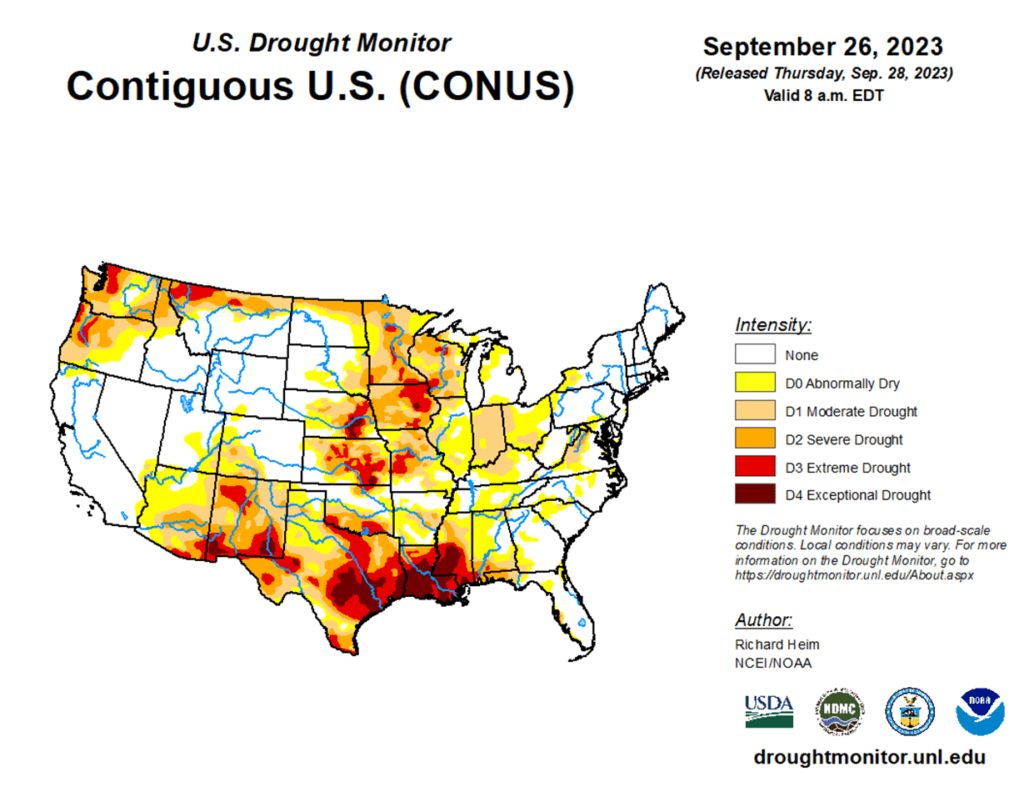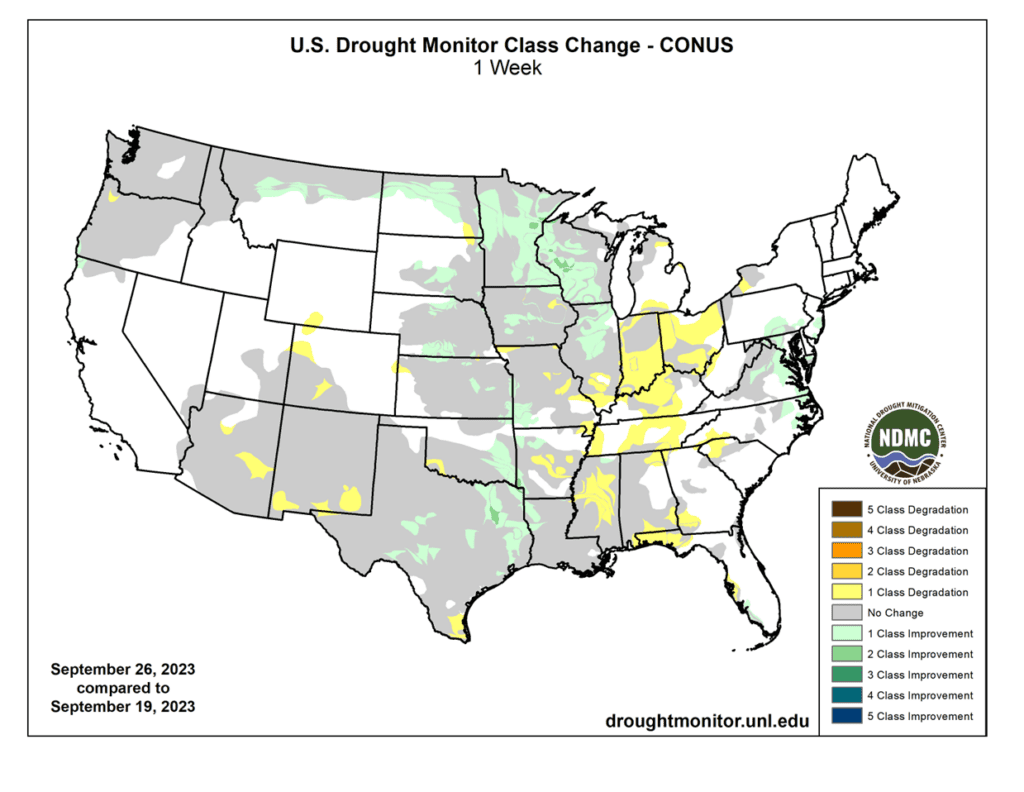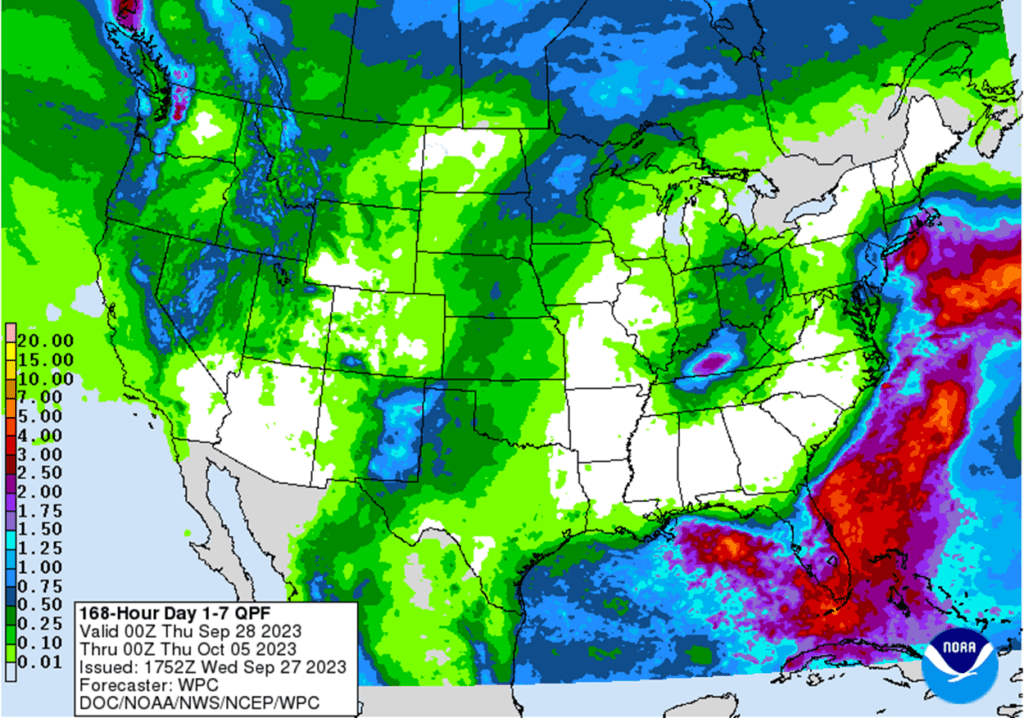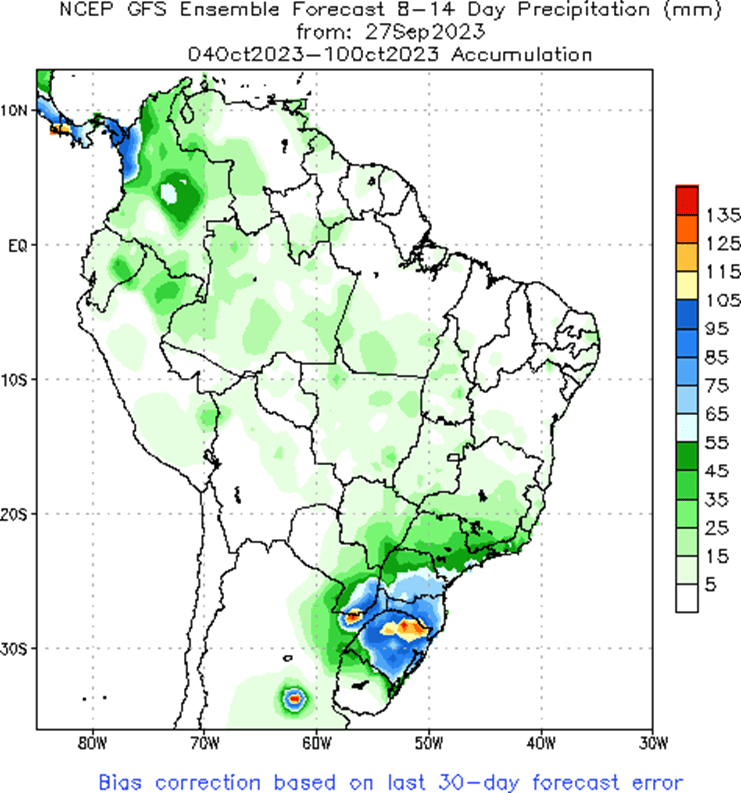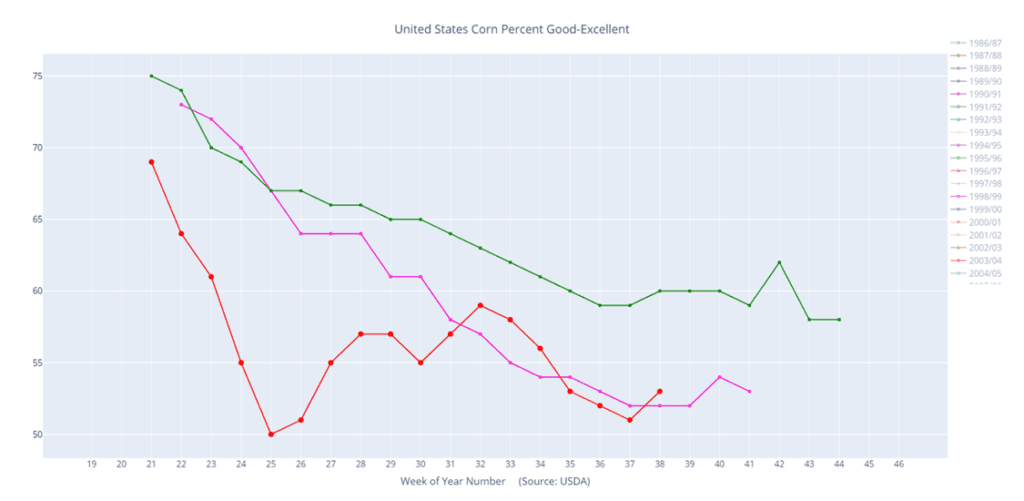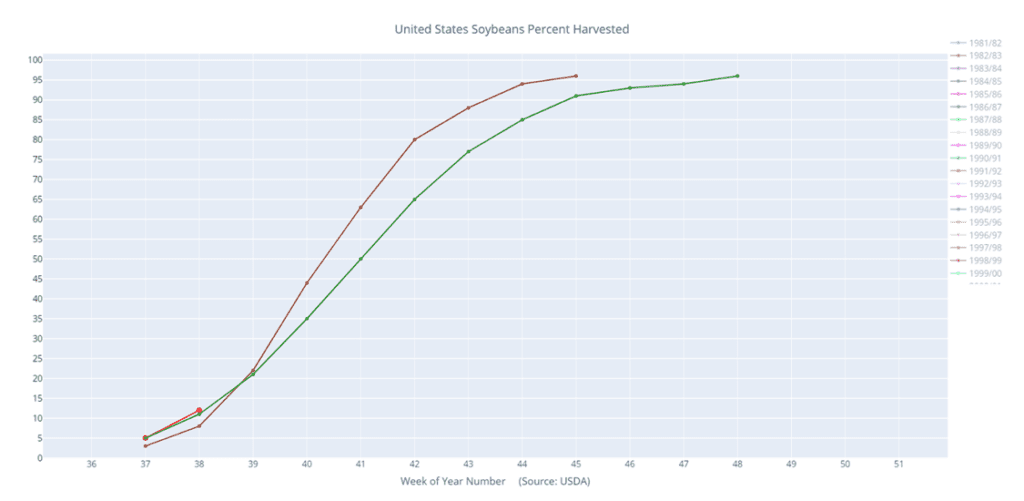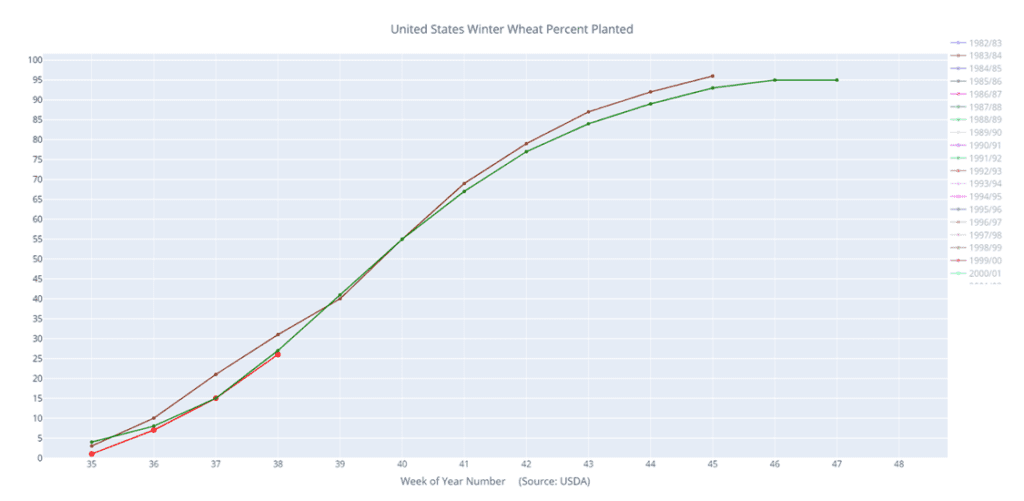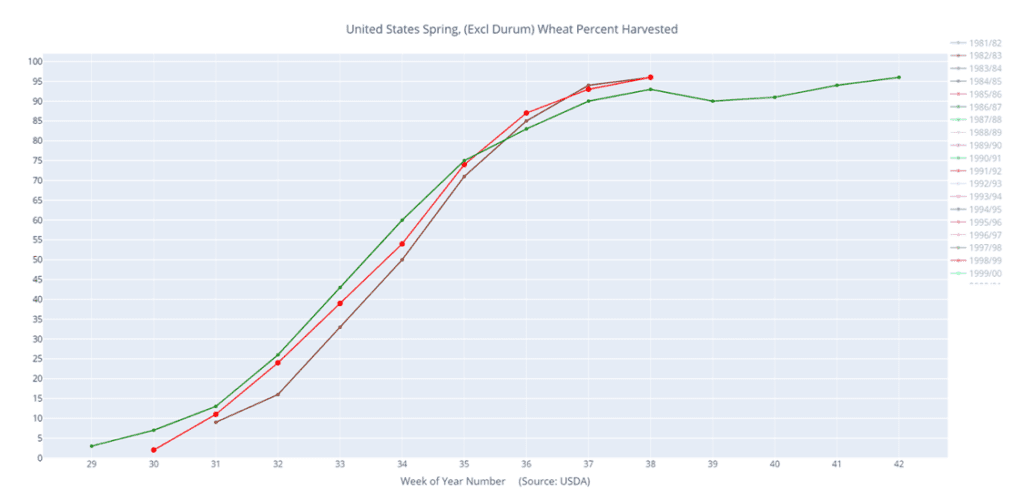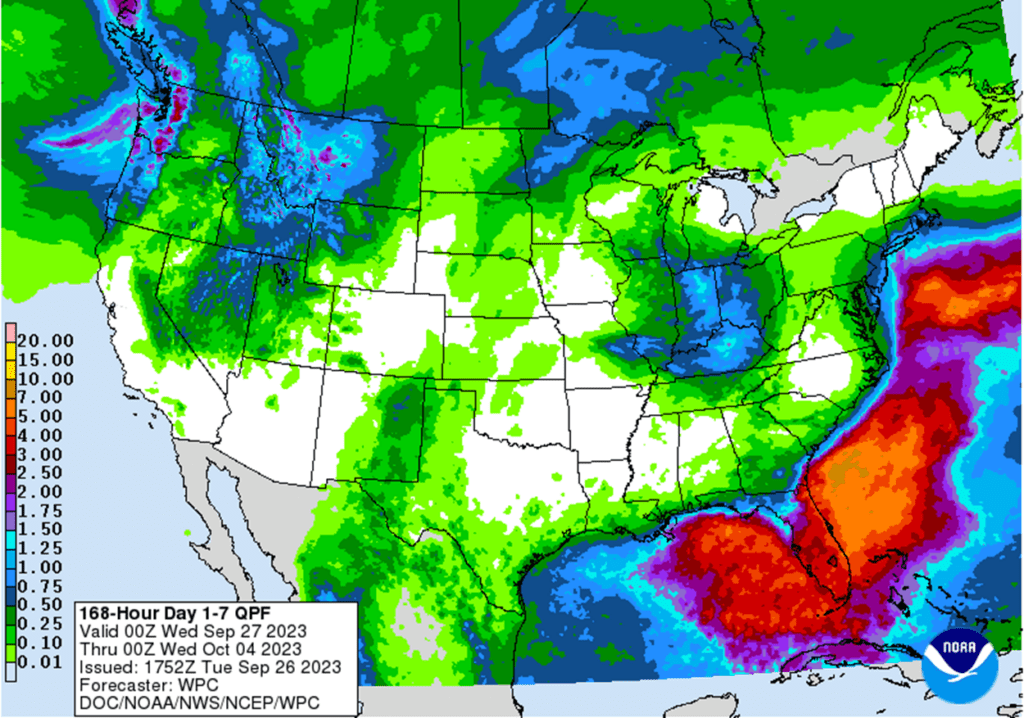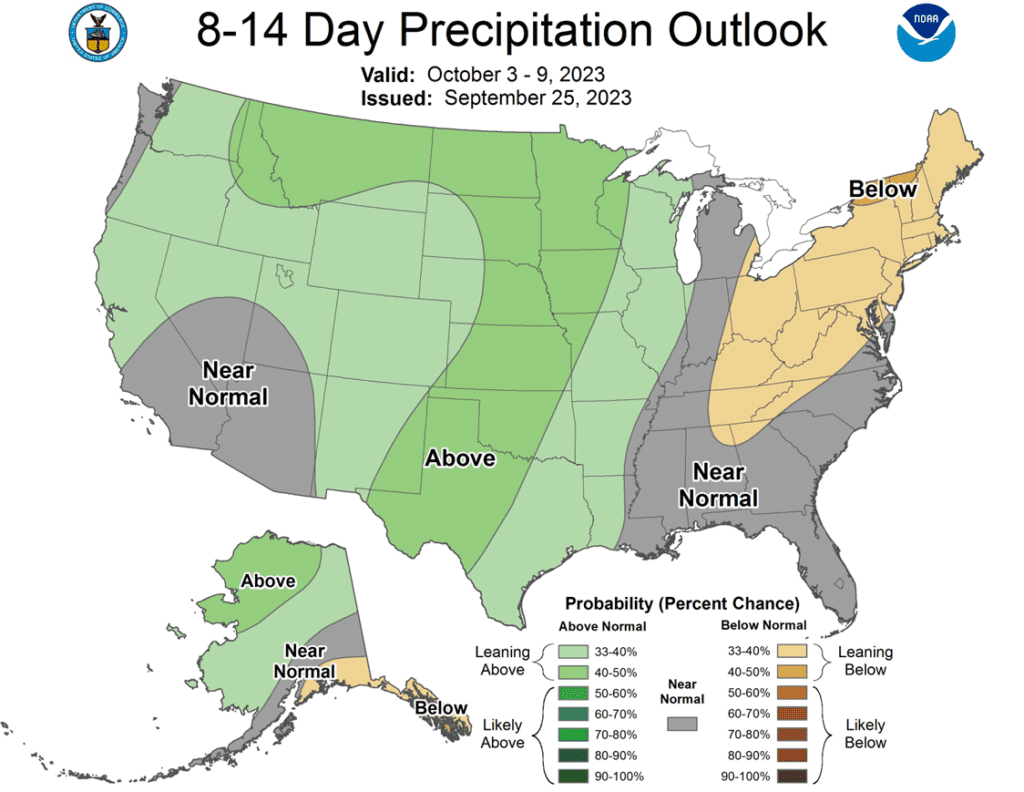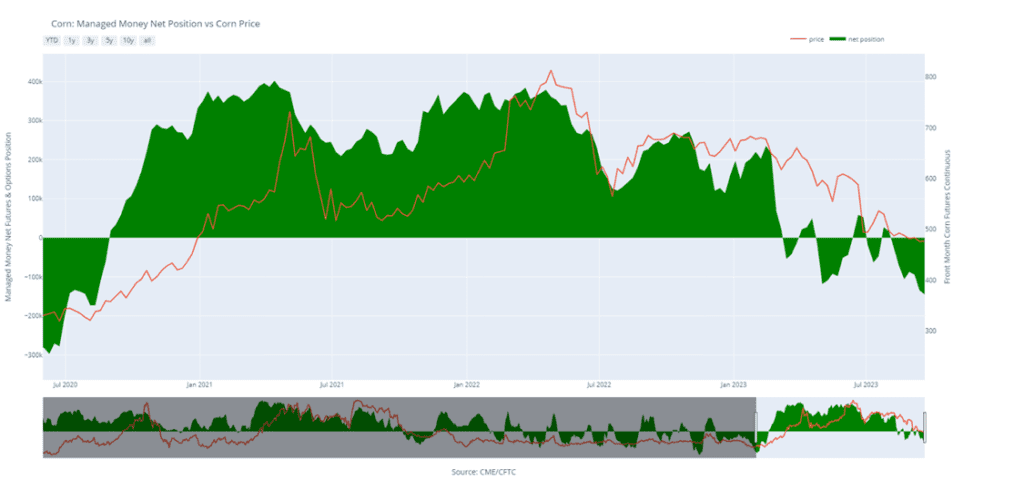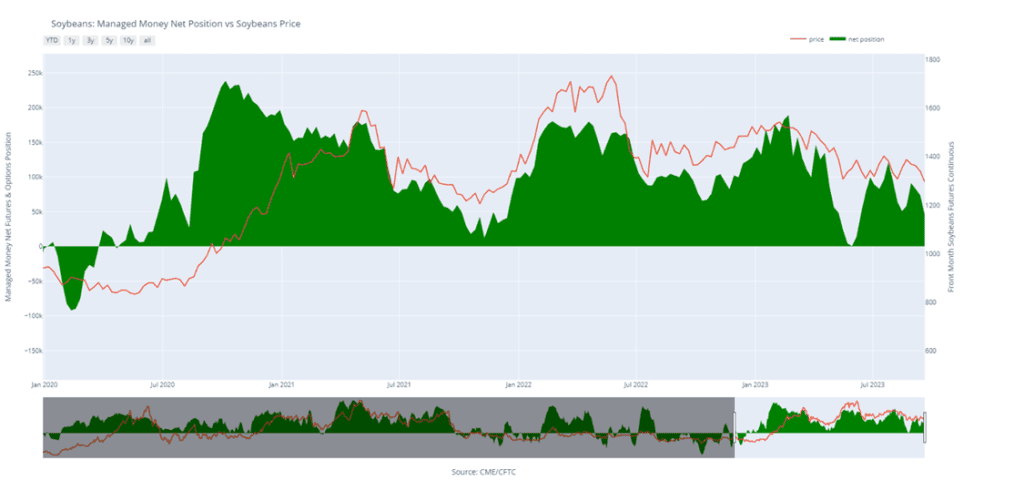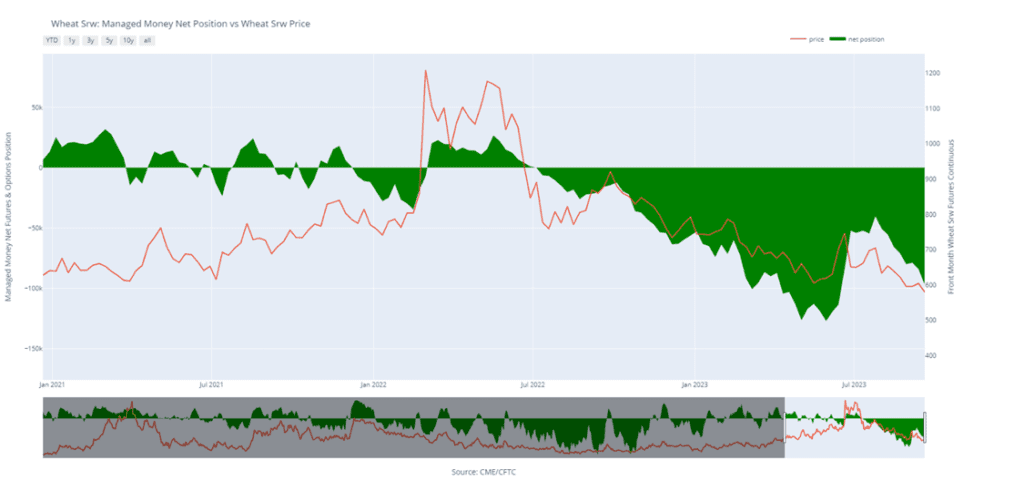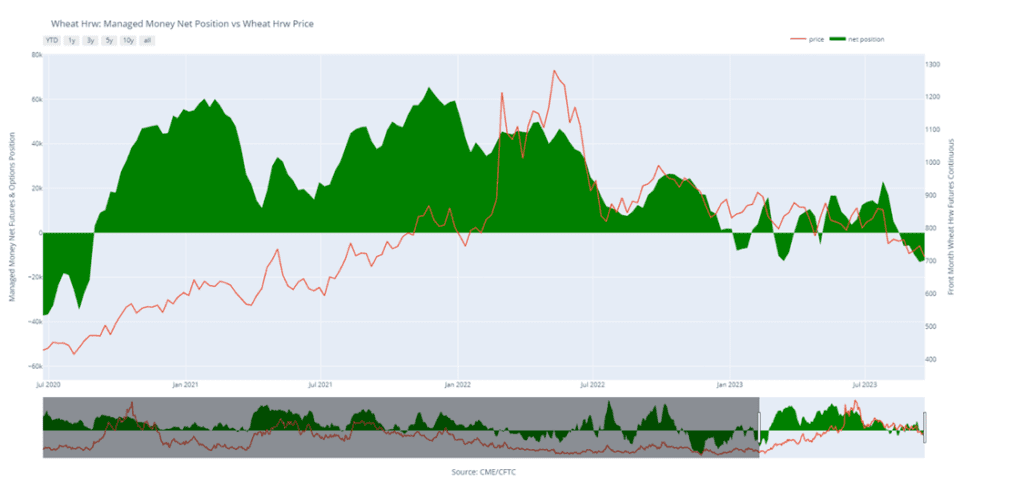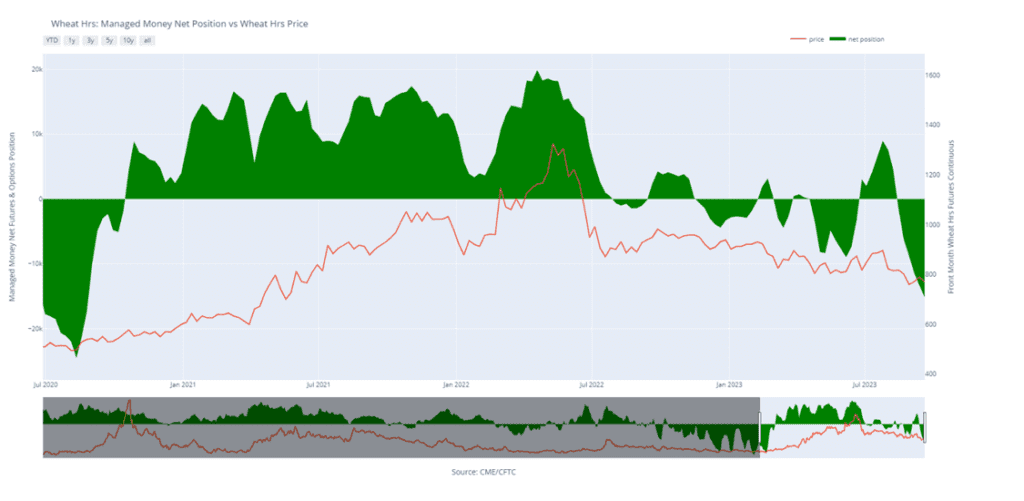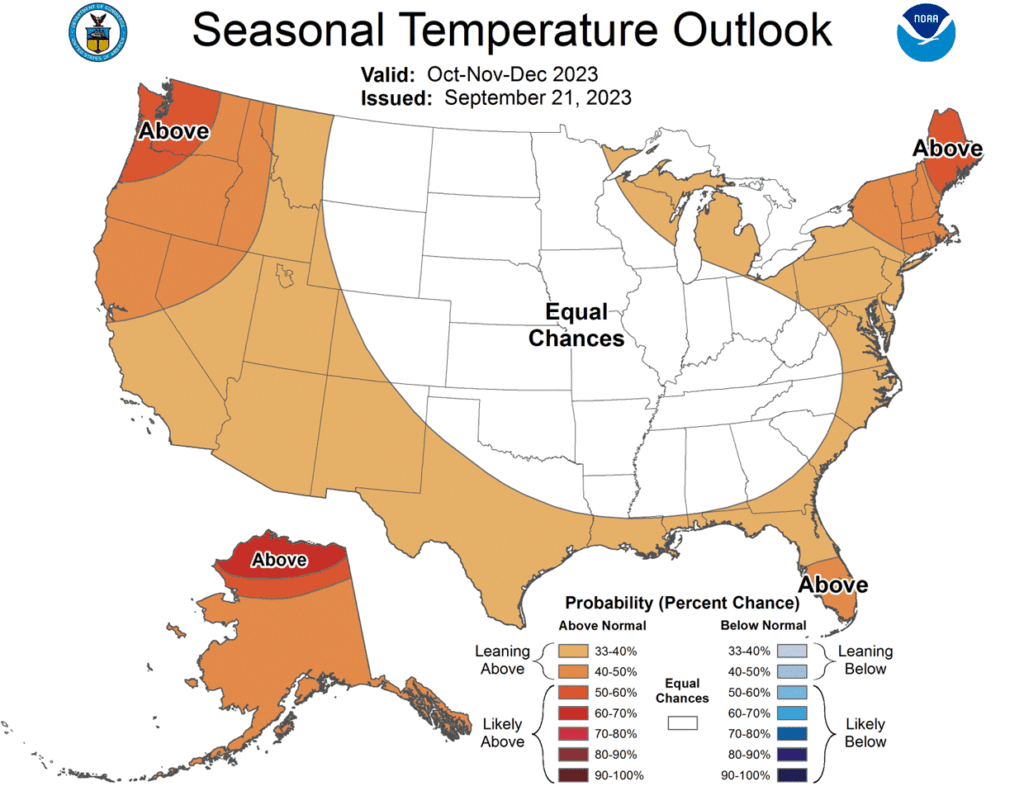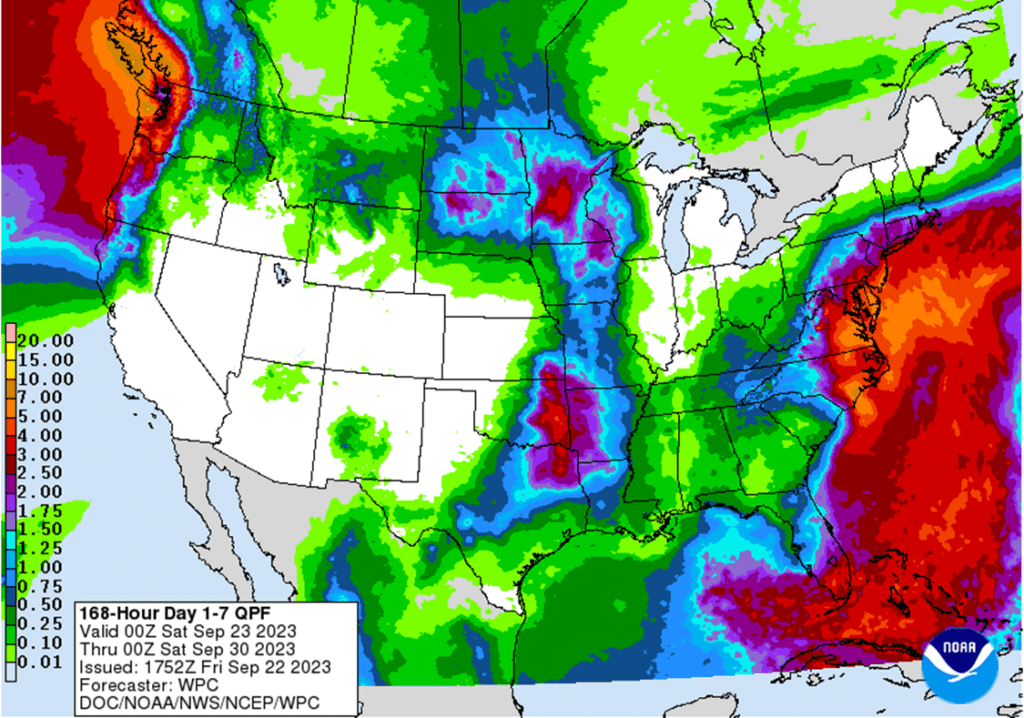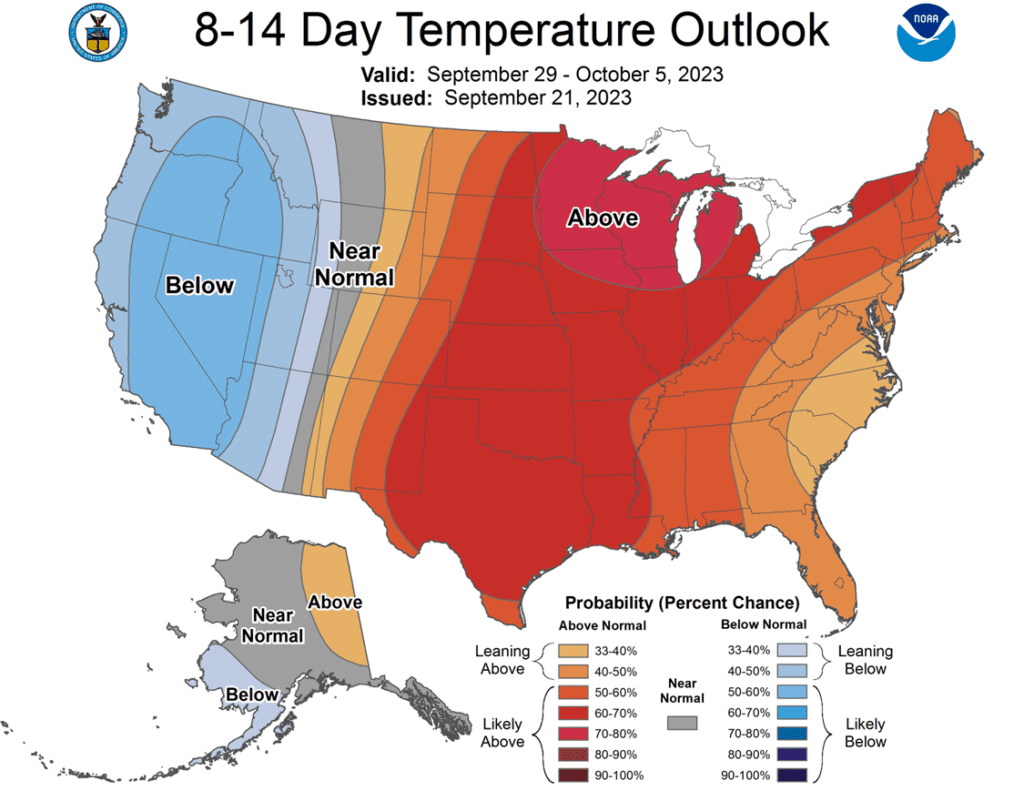Grain Market Insider: October 5, 2023
All prices as of 2:00 pm Central Time
Grain Market Highlights
- Front month corn futures pushed through upside resistance today to close at their highest level since early August. Strong weekly export sales and a push higher in wheat prices aided the rally.
- After trading lower early in the day, soybeans ended the session higher on South American weather worries and strength from both corn and wheat.
- Soybean meal futures, which remain technically oversold, rallied higher today after testing support. Soybean oil did not join rally in soybeans and soybean meal, but rather followed crude oil lower yet again today.
- Wheat futures led the push higher in grains today, closing up double digits across all three classes. Heightened tensions between Russia and Ukraine, as well as wheats’ technically oversold condition are attributed to today’s rally.
- To see the current 8–14-day Temperature and Precipitation Outlooks from NOAA, scroll down to other Charts/Weather Section.
Note – For the best viewing experience, some Grain Market Insider content is best viewed with your phone held horizontally.
Corn
Corn Action Plan Summary
- No new action is recommended for 2023 corn. The 2023 growing season has been marked with many challenges that whipsawed the market up and down in a 140-cent range. And while we are at the time of year when lows are often made, the market is still subject to many unforeseen influences that can move prices higher, like in 2020 when the market went on to test contract highs and beyond after hitting market lows before harvest. For now, after locking in gains from previously recommended purchased 580 puts, Insider is content to wait until later in the year (when markets tend to strengthen) before considering suggesting any additional sales. Insider is also monitoring the market for any re-ownership opportunities, should it experience an extended rally.
- No new action is recommended for 2024 corn. Like the 2023 corn market, prices for the 2024 crop have been dominated by volatility from slow exports and adverse growing conditions which led to a near 80 cent trading range during the summer months. Plenty of time remains to market the crop, and while demand continues to be slow, many uncertainties remain that can move prices higher. After recommending an additional sale for the 2024 crop, Insider may not consider suggesting any further sales until later this winter or possibly even spring. We will continue to monitor the market for any upside opportunities in the coming weeks.
- No Action is currently recommended for 2025 corn. 2025 markets are very illiquid right now, and it may be some time before conditions are conducive to consider making any recommendations. Be patient as we monitor the markets for signs of improvement.

Grain Market Insider has issued the following number of corn recommendations:
• 2023: 1 Cash/2 Call/2 Put
• 2024: 2 Cash/0 Call/0 Put
• 2025: 0 Cash/0 Call/0 Put
- December corn futures pushed through resistance at the $4.90 levels and saw a rounds of short covering and technical buying to post the contracts highest daily close since Aug 8, gaining 11 ½ cents on the day.
- Weekly export sales of corn were strong at 1.82 mmt (71.5 mb) of old crop and 611,400 mt (24.1 mb) of new. Mexico was the largest buyer of U.S. corn last week, which was expected. China did step into the corn market with a small purchase (5.5 mb) of U.S. corn.
- Export shipments were 24.1 mb last week, which was below the pace needed to reach USDA export targets. Corn sales now total 556 mb for 2023-24, up 9% from last year.
- U.S. harvest was 23% complete last week, and pace should continue to be firm this week. The forecast still looks overall friendly to keep harvest moving along at a good pace. Harvest pressure will limit the corn market as fresh supplies pressure the basis and the cash market.
- The corn market rally may still be limited as premiums for Brazilian corn have slipped recently, keeping Brazilian corn still cheaper than U.S. bushels on the export market. Brazilian corn exports for 2023 through September are on record pace, and October exports are expected to reach another record near 8.9 MMT.

Above: The corn market has largely been rangebound since the beginning of August, with some minor short covering lifting prices in recent days. Resistance remains above the market between 490 – 516, and support below the market may be found near 460 and again near 415.

Soybeans
Soybeans Action Plan Summary
- No new action is recommended for 2023 soybeans. This season the market has experienced a lot of volatility, not only from USDA reports but also from changing weather patterns, crop conditions, and export sales. While export demand currently lags last year’s numbers, ending stocks are also currently estimated at a tight 220 million bushels. For now, Insider may not consider suggesting any additional sales until after harvest. Although, we will continue to monitor the market for any upside opportunities in the coming weeks.
- No action is recommended for 2024 crop. Grain Market Insider continues to monitor any developments for 2024 soybeans, and while it may be toward year’s end before we will consider recommending any 2024 crop sales, Insider will keep an eye out for any upside opportunities, should the market experience an extended rally.
- No Action is currently recommended for 2025 Soybeans. 2025 markets are very illiquid right now, and it may be some time before conditions are conducive to consider making any recommendations. Be patient as we monitor the markets for signs of improvement.
Grain Market Insider has issued the following number of soybean recommendations:
• 2023: 2 Cash/0 Call/0 Put
• 2024: 0 Cash/0 Call/0 Put
• 2025: 0 Cash/0 Call/0 Put
- Soybeans ended the day higher following a lower open and continued to hold above support at the 12.56 level. Technically, soybeans are oversold and weather concerns in South America could push prices higher. Soybean meal ended higher, while soybean oil closed lower.
- A week from today is the October WASDE report and it is possible that soybean production gets increased based off early yield estimates, which may be higher than expected. Even with a slight increase in production, stocks will be very tight, and Brazil may be facing some weather troubles due to the El Nino pattern occurring.
- The northern region of Brazil is currently too dry, but in the South, it is far too wet to plant with floods occurring and 4 to 9 inches of rain forecast over the next 10 days. With US ending stocks slated to be so tight, any weather impact on Brazil’s soybean crop could be very friendly for prices.
- Export sales for soybeans were decent with the USDA reporting increases of 29.7 mb for 23/24. Last week’s export shipments of 24.7 mb were below the 35.4 mb needed each week to meet the USDA’s estimates. Primary destinations were China, Spain, and Bangladesh.

Above: The soybean market remains in a downtrend and is oversold, which is supportive if prices turn back higher. Resistance above the market lies between 1285 – 1323. Initial support to the downside lies near 1238 – 1214, with further key support down near 1181.

Wheat
Market Notes: Wheat
- The USDA reported an increase of 10.0 mb of wheat export sales for 23/24. Shipments last week at 14.3 mb were above the 13.9 mb pace necessary to meet the 700 mb export goal. However, total export commitments at 347 mb are down 14% from last year.
- The jump in wheat today was likely both technical and fundamental in nature. From the technical perspective, wheat was oversold and due for a correction to the upside. That may have been initiated on the fundamental side by more war premium being added into the marketplace. A Russian missile attack was said to have killed 49 civilians; additionally, there are reports that a vessel on the way to Ukraine struck a sea mine, but this is currently unconfirmed.
- On top of the above news, there is also talk of UK intelligence warning that Russia may be planting additional mines, meant to target civilian vessels. Meanwhile, there are reports that Germany will send air defenses to Ukraine to thwart Russian attacks on grain shipments.
- Also helping wheat today were higher Matif futures, and a lower US Dollar Index. As of this writing, the index is headed for a second consecutive lower close. Above 106 currently, it does remain at a relatively high level, but if the dollar continues to decline, it should ease pressure on US exports.
- Western Argentina and Australia remain too dry. Rains last week in Argentina were not enough to replenish soil moisture levels. According to the Rosario Exchange, they need about 15-20 milliliters of rain to stabilize the crop, but they are expected to get less than 10 ml over the next several days (according to the Buenos Aires Grain Exchange).
Chicago Wheat Action Plan Summary
- No new action is currently recommended for 2023 Chicago wheat. The wheat market in recent weeks has been sensitive to slow export demand, weather, and headlines regarding the Black Sea region. Now with harvest behind us, and new crop planting upon us, markets can still change suddenly due to El Nino and unforeseen geopolitical events, even though export demand remains weak. Following the recent recommendation to make an additional sale for the 2023 crop, Insider will continue to watch for any violations of support while also looking for prices to reach 650 – 700 before suggesting any further sales.
- No new action is recommended for 2024 Chicago wheat. Considering slow export demand and cheap Russian prices continue to be major headwinds for U.S. prices, Insider recommended buying July ’24 puts to protect unsold grain if prices continue to retreat further. Plenty of time remains to market the 2024 crop with many uncertainties that could shock prices higher, like the world stocks to use ratio at an 8-year low, war in the Black Sea and production concerns in the southern hemisphere. If prices turn around and rally higher, Insider will be looking for opportunities to consider recommending additional sales north of 800, if not, and prices make new lows, unsold bushels will be protected by the recommended July ’24 590 puts.
- No action is currently recommended for 2025 Chicago Wheat. 2025 markets are very illiquid right now, and it may be some time before conditions are conducive to consider making any recommendations. Be patient as we monitor the markets for signs of improvement.

Grain Market Insider has issued the following number of Chicago wheat recommendations:
• 2023: 1 Cash/0 Call/0 Put
• 2024: 2 Cash/0 Call/1 Put
• 2025: 0 Cash/0 Call/0 Put

Above: Chicago wheat broke out of its recent range to the downside following the Sept. 29 Grain Stocks report. Nearby support may be found between 524 – 533, while initial resistance above the market is near the low of the previous range, around 570, with heavier resistance near 618.
KC Wheat Action Plan Summary
- No new action is recommended for 2023 K.C wheat crop. Since the end of May, the wheat market has been influenced by weak demand, changing headlines from the Black Sea region, and the corn market with its own demand and weather concerns. With harvest in the bin, U.S. production has been better than expected and demand remains weak. Still, many supply questions remain unanswered from the Black Sea region and the southern hemisphere, which could push prices in either direction. While Insider will continue to monitor the downside for any breach of major support, we would need to see prices pushed toward 750 – 800 before considering any additional sales.
- No new action is recommended for 2024 K.C. wheat. This year has been dominated by production concerns regarding the 2023 crop, and considering slow export demand and cheap Russian prices continue to be major headwinds for U.S. prices. Insider recently recommended buying July ’24 puts to protect unsold grain if prices continue to retreat further. While war persists in the Black Sea region, production concerns continue in the southern hemisphere due to El Nino, and the world stocks to use ratio remains at an 8-year low. There are still many uncertainties that could shock prices higher, and plenty of time remains to market the 2024 crop. After recommending buying July ’24 660 puts, unsold bushels will be protected if prices make new lows, and if prices turn around and rally higher, Insider will be looking for opportunities to consider recommending additional sales north of 800.
- No action is currently recommended for 2025 KC Wheat. 2025 markets are very illiquid right now, and it may be some time before conditions are conducive to consider making any recommendations. Be patient as we monitor the markets for signs of improvement.

Grain Market Insider has issued the following number of K.C. wheat recommendations:
• 2023: 0 Cash/0 Call/0 Put
• 2024: 1 Cash/0 Call/1 Put
• 2025: 0 Cash/0 Call/0 Put

Above: Since the beginning of September, the market has drifted sideways to lower. The recent breakout to the downside has Dec. K.C. wheat looking toward 630 and 575 for the next levels of support, while nearby resistance on the upside rests between 710 – 722.
Mpls Wheat Action Plan Summary
- No new action is currently recommended for the 2023 New Crop. Weather has been a dominant feature this season with production concerns not only in the U.S., but also Canada and Australia. While prices have been weak due to low export demand, weather and geopolitical events can change suddenly to move prices higher. If prices begin to improve, Insider will consider making sales suggestions, while also continuing to watch the downside for any further violations of support.
- No new action is currently recommended for 2024 Minneapolis wheat. This year has been dominated by production concerns regarding the 2023 crop, and considering slow export demand and cheap Russian prices continue to be major headwinds for prices. Insider recently recommended buying July ’24 K.C. wheat puts to protect unsold grain if prices continue to retreat further. While war persists in the Black Sea region, production concerns continue in the southern hemisphere due to El Nino, and the world stocks to use ratio remains at an 8-year low. There are still many uncertainties that could shock prices higher, and plenty of time remains to market the 2024 crop. After recommending buying July ’24 K.C. wheat 660 puts for the liquidity and high correlation to Minneapolis wheat’s price movements, unsold bushels will be protected if prices make new lows, and if prices turn around and rally higher, Insider will be looking for opportunities to consider recommending additional sales north of 800.
- No action is currently recommended for the 2025 Minneapolis wheat crop. 2025 markets are very illiquid right now, and it may be some time before conditions are conducive to consider making any recommendations. Be patient as we monitor the markets for signs of improvement.

Grain Market Insider has issued the following number of Minneapolis wheat recommendations:
• 2023: 1 Cash/0 Call/0 Put
• 2024: 1 Cash/0 Call/1 Put
• 2025: 0 Cash/0 Call/0 Put

Above: Since early September, Dec Minneapolis wheat has been largely rangebound, and the recent breakout to the downside on September 29 has the market poised to test support near the May ’21 low of 665. If prices turn higher, initial resistance may be found between 745 – 760.

Other Charts / Weather
